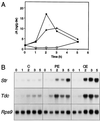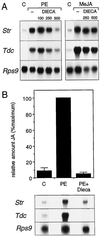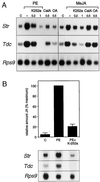Involvement of the octadecanoid pathway and protein phosphorylation in fungal elicitor-induced expression of terpenoid indole alkaloid biosynthetic genes in catharanthus roseus
- PMID: 10198087
- PMCID: PMC32013
- DOI: 10.1104/pp.119.4.1289
Involvement of the octadecanoid pathway and protein phosphorylation in fungal elicitor-induced expression of terpenoid indole alkaloid biosynthetic genes in catharanthus roseus
Abstract
Two key genes in terpenoid indole alkaloid biosynthesis, Tdc and Str, encoding tryptophan decarboxylase and strictosidine synthase, respectively, are coordinately induced by fungal elicitors in suspension-cultured Catharanthus roseus cells. We have studied the roles of the jasmonate biosynthetic pathway and of protein phosphorylation in signal transduction initiated by a partially purified elicitor from yeast extract. In addition to activating Tdc and Str gene expression, the elicitor also induced the biosynthesis of jasmonic acid. The jasmonate precursor alpha-linolenic acid or methyl jasmonate (MeJA) itself induced Tdc and Str gene expression when added exogenously. Diethyldithiocarbamic acid, an inhibitor of jasmonate biosynthesis, blocked both the elicitor-induced formation of jasmonic acid and the activation of terpenoid indole alkaloid biosynthetic genes. The protein kinase inhibitor K-252a abolished both elicitor-induced jasmonate biosynthesis and MeJA-induced Tdc and Str gene expression. Analysis of the expression of Str promoter/gusA fusions in transgenic C. roseus cells showed that the elicitor and MeJA act at the transcriptional level. These results demonstrate that the jasmonate biosynthetic pathway is an integral part of the elicitor-triggered signal transduction pathway that results in the coordinate expression of the Tdc and Str genes and that protein kinases act both upstream and downstream of jasmonates.
Figures






References
-
- Aerts RJ, Gisi D, De Carolis E, De Luca V, Bauman TW. Methyl jasmonate vapor increases the developmentally controlled synthesis of alkaloids in Catharanthus and Cinchona seedlings. Plant J. 1994;5:635–643.
-
- Boller T. Chemoperception of microbial signals in plant cells. Annu Rev Plant Physiol Plant Mol Biol. 1995;46:189–214.
-
- Conconi A, Smerdon MJ, Howe GA, Ryan CA. The octadecanoid signaling pathway in plants mediates a response to ultraviolet radiation. Nature. 1996;383:826–829. - PubMed
LinkOut - more resources
Full Text Sources

